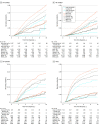Response to Treatment, Racial and Ethnic Disparity, and Survival in Patients With Breast Cancer Undergoing Neoadjuvant Chemotherapy in the US
- PMID: 36995711
- PMCID: PMC10064248
- DOI: 10.1001/jamanetworkopen.2023.5834
Response to Treatment, Racial and Ethnic Disparity, and Survival in Patients With Breast Cancer Undergoing Neoadjuvant Chemotherapy in the US
Abstract
Importance: With the increasing delivery of neoadjuvant chemotherapy (NACT) for patients with breast cancer in the US, it is important to know whether there is differential response to NACT by race and ethnicity and the potential long-term outcomes.
Objective: To examine whether there were any racial and ethnic differences in pathologic complete response (pCR) rate following NACT and, if so, whether they varied by molecular subtype and were associated with survival.
Design, setting, and participants: A retrospective cohort study was conducted including patients with stage I to III breast cancer diagnosed between January 2010 and December 2017 who underwent surgery and received NACT; median follow-up was 5.8 years, and data analysis was conducted from August 2021 to January 2023. Data were obtained from the National Cancer Data Base, a nationwide, facility-based, oncology data set that captures approximately 70% of all newly diagnosed cases of breast cancer in the US.
Main outcomes and measures: Pathologic complete response, defined as ypT0/Tis ypN0, was modeled using logistic regression. Racial and ethnic differences in survival were analyzed using a Weibull accelerated failure time model. Mediation analysis was conducted to measure whether racial and ethnic differences in the pCR rate affect survival.
Results: The study included 107 207 patients (106 587 [99.4%] women), with a mean (SD) age of 53.4 (12.1) years. A total of 5009 patients were Asian or Pacific Islander, 18 417 were non-Hispanic Black, 9724 were Hispanic, and 74 057 were non-Hispanic White. There were significant racial and ethnic differences in pCR rates, but the differences were subtype-specific. In hormone receptor-negative (HR-)/erb-b2 receptor tyrosine kinase 2 (ERBB2; formerly HER2 or HER2/neu)-positive (ERBB2+) subtype, Asian and Pacific Islander patients achieved the highest pCR rate (56.8%), followed by Hispanic (55.2%) and non-Hispanic White (52.3%) patients with the lowest pCR rate seen in Black patients (44.8%). In triple-negative breast cancer, Black patients had a lower pCR rate (27.3%) than other racial and ethnic groups (all >30%). In HR+/ERBB2- subtype, Black patients had a higher pCR rate (11.3%) than other racial/ethnic groups (all ≤10%). In mediation analysis, racial and ethnic differences in achieving pCR after NACT could explain approximately 20% to 53% of the subtype-specific survival differences across racial and ethnic groups.
Conclusions and relevance: In this cohort study of patients with breast cancer receiving NACT, Black patients had a lower pCR rate for triple-negative and HR-/ERBB2+ breast cancer but a higher pCR rate for HR+/ERBB2- diseases, whereas Asian and Pacific Islander patients had a higher pCR rate for HR-/ERBB2+ diseases. Tumor grade and ERBB2 copy number could account for some of these within-subtype disparities, but further studies are warranted. Inability to achieve a pCR can mediate in part, but not entirely, the worse survival outcomes experienced by Black patients.
Conflict of interest statement
Figures


Similar articles
-
Racial/ethnic disparities in costs, length of stay, and severity of severe maternal morbidity.Am J Obstet Gynecol MFM. 2023 May;5(5):100917. doi: 10.1016/j.ajogmf.2023.100917. Epub 2023 Mar 5. Am J Obstet Gynecol MFM. 2023. PMID: 36882126 Free PMC article.
-
Clinicopathologic Characteristics and Prognosis of ERBB2-Low Breast Cancer Among Patients in the National Cancer Database.JAMA Oncol. 2023 Apr 1;9(4):500-510. doi: 10.1001/jamaoncol.2022.7476. JAMA Oncol. 2023. PMID: 36821125 Free PMC article.
-
Racial and Ethnic Variation in Survival in Early-Onset Colorectal Cancer.JAMA Netw Open. 2024 Nov 4;7(11):e2446820. doi: 10.1001/jamanetworkopen.2024.46820. JAMA Netw Open. 2024. PMID: 39576642 Free PMC article.
-
Racial and Ethnic Minorities Underrepresented in Pain Management Guidelines for Total Joint Arthroplasty: A Meta-analysis.Clin Orthop Relat Res. 2024 Sep 1;482(9):1698-1706. doi: 10.1097/CORR.0000000000003026. Epub 2024 Mar 18. Clin Orthop Relat Res. 2024. PMID: 38497759 Free PMC article.
-
Impact of residual disease as a prognostic factor for survival in women with advanced epithelial ovarian cancer after primary surgery.Cochrane Database Syst Rev. 2022 Sep 26;9(9):CD015048. doi: 10.1002/14651858.CD015048.pub2. Cochrane Database Syst Rev. 2022. PMID: 36161421 Free PMC article.
Cited by
-
Racial Disparities in Pathological Complete Response Among Patients Receiving Neoadjuvant Chemotherapy for Early-Stage Breast Cancer.JAMA Netw Open. 2023 Mar 1;6(3):e233329. doi: 10.1001/jamanetworkopen.2023.3329. JAMA Netw Open. 2023. PMID: 36995716 Free PMC article.
-
Trends and Disparities in the Use of Immunotherapy for Triple-Negative Breast Cancer in the US.JAMA Netw Open. 2025 Feb 3;8(2):e2460243. doi: 10.1001/jamanetworkopen.2024.60243. JAMA Netw Open. 2025. PMID: 39960669 Free PMC article.
-
Towards targeting the breast cancer immune microenvironment.Nat Rev Cancer. 2024 Aug;24(8):554-577. doi: 10.1038/s41568-024-00714-6. Epub 2024 Jul 5. Nat Rev Cancer. 2024. PMID: 38969810 Review.
-
Predicting the efficacy of neoadjuvant chemotherapy in breast cancer patients based on ultrasound longitudinal temporal depth network fusion model.Breast Cancer Res. 2025 Feb 27;27(1):30. doi: 10.1186/s13058-025-01971-5. Breast Cancer Res. 2025. PMID: 40016785 Free PMC article.
-
Bridging the United States population diversity gaps in clinical research: roadmap to precision health and reducing health disparities.Per Med. 2025 Jun;22(3):193-203. doi: 10.1080/17410541.2025.2504329. Epub 2025 May 13. Per Med. 2025. PMID: 40358454 Review.
References
-
- Yee D, DeMichele AM, Yau C, et al. ; I-SPY2 Trial Consortium . Association of event-free and distant recurrence-free survival with individual-level pathologic complete response in neoadjuvant treatment of stages 2 and 3 breast cancer: three-year follow-up analysis for the I-SPY2 adaptively randomized clinical trial. JAMA Oncol. 2020;6(9):1355-1362. doi:10.1001/jamaoncol.2020.2535 - DOI - PMC - PubMed
-
- Boughey JC, McCall LM, Ballman KV, et al. . Tumor biology correlates with rates of breast-conserving surgery and pathologic complete response after neoadjuvant chemotherapy for breast cancer: findings from the ACOSOG Z1071 (Alliance) prospective multicenter clinical trial. Ann Surg. 2014;260(4):608-614. doi:10.1097/SLA.0000000000000924 - DOI - PMC - PubMed
Publication types
MeSH terms
Grants and funding
LinkOut - more resources
Full Text Sources
Research Materials
Miscellaneous

